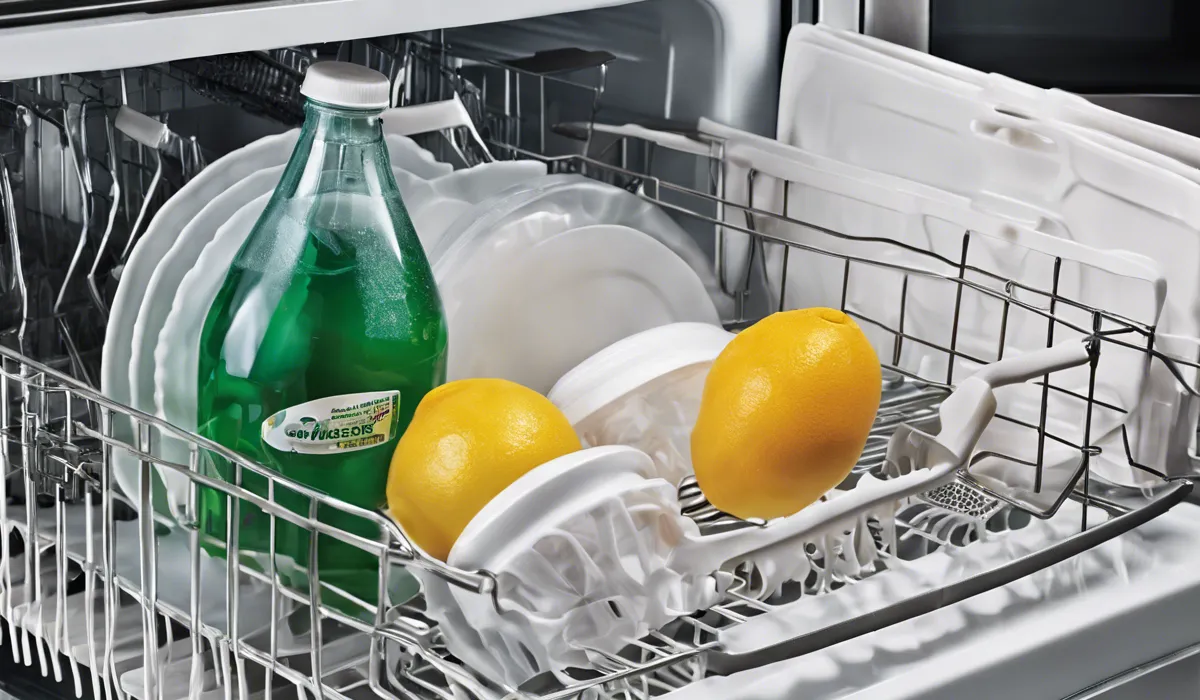Can Plastic Go in the Dishwasher? Safety & Tips Guide
Not all plastic items are dishwasher-safe. Check for a dishwasher-safe symbol or label on the plastic. Generally, place safe plastics on the top rack to avoid heat damage from the heating element below. Avoid washing plastics with a low melting point or that contain BPA.
Understanding Dishwasher Safety Symbols on Plastics

Explanation of the Dishwasher-Safe Symbol
When you see a plastic container, cup, or utensil, the first step before placing it into your dishwasher is to look for the dishwasher-safe symbol.
This symbol, typically depicted as a plate or glass with water droplets above it or a square box with the same imagery, indicates that the item can withstand the rigors of dishwasher cleaning.
It’s a manufacturer’s assurance that the item has been tested and can handle high temperatures and water pressure without degrading.
The Importance of Checking for This Symbol Before Washing
Not all plastics are created equal. Some can melt, warp, or leach chemicals when exposed to high heat, making it crucial to check for the dishwasher-safe symbol before washing.
Using plastics not intended for the dishwasher can not only damage the item but also potentially release harmful chemicals into your dishwasher, posing a health risk.
Common Symbols and What They Mean
Common dishwasher-safe symbols include a plate or glass with water droplets, sometimes accompanied by the text “dishwasher safe.” A cup and fork symbol signifies that the plastic is safe for food use.
A snowflake symbol may indicate that the item is also freezer-safe. Familiarizing yourself with these symbols ensures that you’re using your kitchenware as intended.
Variations in Symbols Across Different Countries or Manufacturers
Symbols can vary across different countries and manufacturers. While the basic imagery is generally consistent, the style or additional text may differ. It’s always a good idea to consult the manufacturer’s guidelines if you’re unsure.
This ensures that your plastic items remain in good shape and your dishes come out clean and safe.
Types of Plastics and Their Dishwasher Compatibility

Overview of Plastic Categories
Plastics are categorized by their resin identification codes, ranging from PET (Polyethylene Terephthalate) to PS (Polystyrene). Each type of plastic has unique properties that affect its dishwasher compatibility.
PET, for example, is often used in beverage bottles and is generally not recommended for the dishwasher as it can warp and leach chemicals.
General Rules for Which Plastics Typically Can/ Cannot Go in the Dishwasher
As a rule of thumb, high-density plastics like HDPE (High-Density Polyethylene) and PP (Polypropylene) are more likely to be dishwasher safe.
In contrast, plastics like PVC (Polyvinyl Chloride) and PS (Polystyrene) are more prone to heat damage and should generally be kept out of the dishwasher. Always look for the dishwasher-safe symbol as your definitive guide.
Impact of Heat and Water Pressure on Different Plastics
Heat and water pressure in dishwashers can cause certain plastics to melt, warp, or crack.
This is especially true for thin or low-quality plastics. Over time, repeated exposure to these conditions can degrade the plastic, potentially leading to leaks or the release of chemicals.
Special Considerations for Plastic Items with Multiple Components
Items like insulated mugs or containers with rubber seals require extra caution. These components can be sensitive to heat and may degrade or lose their insulating properties.
It’s best to hand wash these items or consult the manufacturer’s recommendations to avoid damage.
Best Practices for Washing Plastics in the Dishwasher

Tips for Loading Plastics Safely in the Dishwasher
To prevent damage to your plastics, place them on the top rack of the dishwasher. This area is farther from the heating element, reducing the risk of warping or melting.
Lightweight items should be secured to prevent them from flipping over and filling with water or falling onto the heating element.
Significance of Wash Cycle Selection for Plastic Items
Selecting the right wash cycle is crucial for plastic items. A gentle or eco-friendly cycle that uses lower temperatures can clean effectively while minimizing the risk of damage.
Heavier cycles with high heat drying should be avoided for plastics not explicitly labeled as dishwasher safe.
The Role of Detergent Choice When Washing Plastics
The detergents you use can also affect plastic items. Choose a mild detergent and avoid harsh chemicals that can cause plastic to degrade over time.
Some detergents are formulated specifically for use with plastics and can help keep them looking clear and free from residue.
Preventive Measures to Avoid Warping, Melting, and Chemical Leaching
To prevent warping and melting, avoid placing plastics on the bottom rack or near the dishwasher’s heating element. To prevent chemical leaching, use plastics that are free from BPA and phthalates, especially for items that come into contact with food.
Alternatives to Dishwasher Cleaning for Plastics that are Not Dishwasher-Safe
For plastics that are not dishwasher-safe, hand washing with warm soapy water is the best alternative.
This method is gentler and allows you to control the temperature and handling of your plastic items, ensuring they last longer and remain free from harmful chemicals.
FAQs About Dishwasher-Safe Plastics
Can all plastic items be washed in the dishwasher?
Not all plastic items are dishwasher-safe. It’s important to check for a dishwasher-safe symbol or label before washing plastic items in the dishwasher.
How can I tell if a plastic item is safe for the dishwasher?
Look for a dishwasher-safe symbol or label on the plastic item, which usually indicates it can be safely washed in a dishwasher.
Where should I place dishwasher-safe plastics in the dishwasher?
Generally, it is recommended to place dishwasher-safe plastics on the top rack of the dishwasher to avoid potential heat damage from the heating element below.
Is it safe to wash plastics with a low melting point in the dishwasher?
It is best to avoid washing plastics with a low melting point in the dishwasher as they may warp or melt due to the heat.
Should I wash plastic containers that contain BPA in the dishwasher?
Plastics that contain BPA should generally not be washed in the dishwasher as high heat can cause BPA to leach out of the plastic.
Final Thoughts
Assess each plastic item for a dishwasher-safe symbol before loading it into the machine. To protect them from heat damage, place recognized safe plastics on the top rack, as the heating element is usually at the bottom.
Steer clear of dishwashing plastics with low melting points or those that contain BPA for health and safety reasons.





